A moderate federalist, José Joaquín de Herrera was a career army officer and politician. He ascended to the presidency in late 1845 following the revolt against Santa Anna, only to be deposed a year later. He was elected President a second time in 1848 and became the first constitutionally elected president to pass the office to his constitutionally elected successor.
Born of Creole parents on February 23, 1792, in Jalapa, Herrera grew up in Perote. In 1809, he joined the Mexican army, siding initially with royalist forces during the fight for independence. By 1820 he had become disillusioned and resigned from the army, returning to Perote where he opened an apothecary shop. The following year, however, he joined the forces of Agustín de Iturbide. As commander of the ninth division of the Imperial Grenadiers, he was instrumental in wresting eastern and central Mexico from royalist control.
When the new Congress convened in February 1822, Herrera, now a brigadier general, was elected as a representative from the State of Vera Cruz, aligning with other Creole moderates who favored a federalist system similar to that of the United States. He was briefly imprisoned for conspiracy when Iturbide declared himself emperor and dissolved Congress. After Iturbide’s fall from power, Herrera served briefly as secretary of War and Marine (1823–24). From 1824 to1834 he served as commandant-general of several states, and in 1833 served again as secretary of war, resigning the following year when Santa Anna took steps to abolish the Constitution of 1824.
A moderate who had support among liberals and conservatives, Herrera became interim president in December, 1844 following the overthrow of Santa Anna and his successor, Valentín Canalizo. The so-called “three hour” coup was unique in that it was not based on ideological motives or any one group’s intent on constitutional reform; rather it was an alliance of various factions, at least in the short term, determined to remove Santa Anna.
As president, Herrera proposed reforms that improved the army but alienated its leadership. He simplified the command structure, changed the promotion process to reward merit, and clarified the powers of state governors and military commanders. He also attempted, unsuccessfully, to reform the popular civil militias (cívicos), a measure nonetheless widely perceived by conservatives as an attempt to establish a counterweight to the regular army.
Almost immediately, the Herrera government faced a diplomatic crisis that threatened its existence: the annexation of Texas to the United States. In March 1845, the Herrera regime severed diplomatic relations with the United States as a result of its offer to annex the Lone Star republic. It further announced that a union between Texas and the United States would constitute an act of war. Privately, however, Herrera hoped to avoid a confrontation with the United States. Though he continued to look for ways to block annexation, the moderate federalist sought to resist the bellicose demands of Mexican nationalists who called for war.
Hoping to achieve a negotiated settlement that would include obtaining compensation for Texas, the government notified Washington that it was prepared to receive an envoy from the United States. The decision was roundly condemned by federalists and centralists alike.
Leading the effort to supplant the federalist government was General Manuel Paredes y Arillaga, commander of the army at San Luis Potosi. In an attempt to discourage Paredes from undermining the government, Herrera ordered the general to march to the Rio Grande. Paredes refused, and in December the garrison at San Luis Potosi issued a pronunciamiento calling for the overthrow of Herrera. Herrera issued an address to the Mexican people in defending his Texas policy, but without the support of the army, he could offer little resistance, and resigned the office as Paredes’s troops neared the capital.
During the U.S.-Mexico War Herrera served again as a deputy from Vera Cruz, and in 1847 headed the preliminary peace commission that met with Nicholas Trist in September. He briefly superseded Santa Anna as army commander following Santa Anna’s defeat at the Battle of Huamantla the following month.
In 1848, Herrera bowed to pressure from various factions to accept the presidency. His administration faced numerous challenges, including a rebellion led by General Mariano Paredes who opposed the treaty of Guadalupe Hidalgo. The rebels marched to Guanajuato but failed to win support. Shortly after putting down the revolt, Herrera was forced to contend with civilian unrest in the Sierra Gorda region and a bloody caste war in the Yucatán.
In January 1850, Herrera turned over the office of president to Mariano Arista. For three years he served as director of the Monte de Piedad, a bank and pawnshop for the nation’s poor, still in existence today. He died on February 10, 1854, in Tacubaya.
Bibliography
Cotner, Thomas E. The Military and Political Career of José Joaquín de Herrera, 1792-1854. The University of Texas Press, 1949. Reprinted by Greenwood Press, 1969.
Costeloe, Michael. The Central Republic in Mexico, 1835-1846: Hombres de Bien in the Age of Santa Anna. York: Cambridge University Press, 1993.
Soto, Miguel E. “The Monarchist Conspiracy and the Mexican War.” Essays on the Mexican War, edited by Douglas W. Richmond, 66-84. College Station: Texas A&M University Press, 1986
Henderson, Timothy. A Glorious Defeat: Mexico and its War with the United States. New York: Hill and Wang, 2007.

